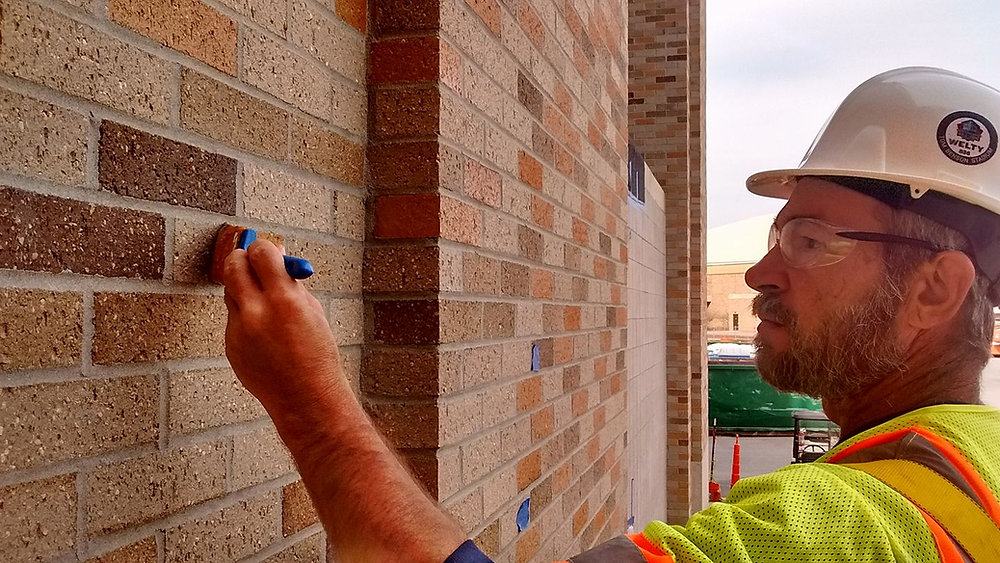
Masonry staining is a process that involves adding color and depth to the natural beauty of brick, stone, concrete, and other masonry surfaces. This technique not only enhances the appearance of these structures, but it also helps protect them from environmental damage. However, mastering the art of masonry staining can be a daunting task for both novice and experienced individuals alike. With so many products, techniques, and variables involved, it can be overwhelming to know where to begin. That’s why we have created the ultimate guide to masonry staining, compiling the most useful tips and tricks to help you achieve stunning and long-lasting results. Whether you are a DIY enthusiast or a professional contractor, this comprehensive guide will provide you with all the information you need to know about masonry staining, from preparation and application to aftercare and maintenance. So, let’s dive into this guide and discover the secrets to achieving flawless masonry staining that will leave your surfaces looking vibrant and protected for years to come.
Preparing the surface for staining
Before proceeding with staining your masonry surface, it is crucial to properly prepare the area to ensure optimal results. The first step is to thoroughly clean the surface by removing any dirt, debris, or previous coatings. This can be done using a pressure washer or a stiff brush combined with a mild detergent. Be sure to pay extra attention to areas with stubborn stains or mold growth, using appropriate cleaners or bleach if necessary. Once the surface is clean and dry, inspect it for any cracks, chips, or other damages that may need to be repaired before staining. Fill in any gaps with an appropriate masonry repair product and allow it to cure completely. Additionally, it is important to protect surrounding areas from potential staining by using masking tape or plastic sheeting. Taking the time to properly prepare the surface will ensure that the stain adheres evenly and provides a long-lasting, beautiful finish.
Choosing the right stain for your project
When it comes to choosing the right stain for your masonry project, there are a few factors to consider. First and foremost, you’ll want to determine the desired outcome and the look you want to achieve. Stains are available in a variety of colors, from natural tones that enhance the natural beauty of the masonry to more vibrant options for a bold statement. Consider the style and architecture of your project, as well as any existing color schemes or design elements in the surrounding area.
Another important consideration is the type of masonry surface you’ll be staining. Different stains are formulated for specific materials such as brick, concrete, or stone. It’s crucial to select a stain that is compatible with the surface you’re working with to ensure proper adhesion and longevity.
Additionally, take into account the level of protection you desire for your masonry. Some stains offer more than just color enhancement – they can also provide added protection against water damage, UV rays, and even mold or mildew growth. Determine whether you prioritize aesthetic appeal or functional benefits, or if you’re looking for a stain that offers a balance of both.
Lastly, consider the application method and ease of use. Some stains are designed for spray application, while others are better suited for brushing or rolling. Take into account your comfort level with different application techniques and choose a stain that aligns with your preferences and skill level.
By carefully considering these factors and selecting the right stain for your masonry project, you can ensure a successful and visually pleasing result that enhances the beauty and durability of your surface.
Applying the stain like a pro
To achieve professional-looking results when applying stain to masonry, there are a few key steps to follow. First, it’s important to thoroughly prepare the surface by cleaning it of any dirt, debris, or previous coatings. This can be done using a pressure washer or a suitable cleaning solution.
Next, ensure that the surface is completely dry before applying the stain. Moisture can interfere with the absorption of the stain and result in uneven color distribution. Allow ample time for the masonry to dry, especially if you have recently cleaned it.
Before applying the stain, it’s a good idea to test it on a small, inconspicuous area of the masonry. This will allow you to assess how the color will appear and ensure that you are happy with the result before proceeding with the entire project.
When applying the stain, use a brush or roller specifically designed for masonry surfaces. Start from the top and work your way down, applying thin, even coats. It’s better to apply multiple thin coats rather than one thick coat, as this will help achieve a more uniform and natural-looking finish.
Take care to avoid overlapping or applying too much stain in one area, as this can lead to darker patches or streaks. If you do notice any unevenness, gently blend the stain with a brush or sponge to create a more seamless appearance.
Finally, allow the stain to fully dry and cure according to the manufacturer’s instructions. This will ensure that the color sets properly and enhances the beauty of the masonry while providing the desired protection.
By following these tips and applying the stain with care and precision, you can achieve a Professional Masonry Staining finish that enhances the beauty and longevity of your masonry project.
Masonry staining may seem like a daunting task, but with the right knowledge and techniques, it can be a simple and effective way to enhance the appearance and protection of your home. From choosing the right stain to properly preparing and applying it, this ultimate guide has provided you with various tips and tricks to achieve professional-looking results. With these insights in mind, you can confidently tackle your next masonry staining project and create a beautiful and long-lasting finish for your property. So go ahead and give it a try, and see the amazing transformation that proper staining can bring to your masonry surfaces.





